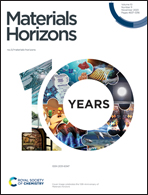Ductile amorphous boron nitride microribbons†
Abstract
The broad applications of ceramic materials in functional devices are often limited by their intrinsic brittleness. Amorphous boron nitride (a-BN), as a promising ceramic has shown high thermal stability and excellent dielectric properties that can be applied to microfabricated aerogel and nano dielectric layers, while its mechanical properties at small scales are yet to be studied. Here we report synthesized a-BN microribbons can have a uniform elongation at a breaking strain of more than 50% upon tension, exhibiting outstanding ductility. Such a-BN microribbons with lengths ranging from tens to hundreds of micro-meters were prepared via the small molecule precursors sol–gel method. Through in situ uniaxial tensile measurements, we demonstrated that a-BN microribbons also display a surprising flaw-tolerance behaviour. Combining high-resolution atomic characterization with molecular dynamics simulations, we reveal that the large tensile plasticity of a-BN originates from the topological deformation induced multiple energy-dissipation mechanisms including unfolding and reorientation of local curly h-BN layers and their interlayer debonding, slippage as well as the intralayer tearing. Our findings provide new insights to develop ductile amorphous covalent-bonded materials for emerging applications.



 Please wait while we load your content...
Please wait while we load your content...